INSTITUT SUPERIEUR D'ANTHROPOLOGIE
INSTITUTE OF ANTHROPOLOGY
ONLINE COURSES / COURS A DISTANCE
FALL TERM : OCTOBER 2013
REGISTER NOW
JAPON –  Kamei - Archaeologist Susumu Morimoto recently made a landmark discovery that could change today’s views of Japan’s ancient measuring system and of the Yayoi Period (300 B.C. to 300). The head of the International Cooperation Section at the Nara National Research Institute for Cultural Properties discovered that what were believed to be grinding stones from the first half of Yayoi, about 2,400 years ago, are actually weights for scales. Morimoto had been obsessed with the 11 stones ever since he saw them about 30 years ago after they were excavated from the Kamei site in Osaka Prefecture, where there used to be a village surrounded by a moat during the Yayoi Period. The cylindrical stones, which are 3 to 8 cm long with a radius of 1 to 4.5 cm, are more than 500 years older than the previous oldest bronze weights from the latter half of Yayoi that were unearthed from the Harunotsuji site in Iki, Nagasaki Prefecture. Morimoto said he doubted the stones from the Kamei site were used as grinders because they looked different from any of the grinders he had researched and because he was unable to confirm any grinding traces.
Kamei - Archaeologist Susumu Morimoto recently made a landmark discovery that could change today’s views of Japan’s ancient measuring system and of the Yayoi Period (300 B.C. to 300). The head of the International Cooperation Section at the Nara National Research Institute for Cultural Properties discovered that what were believed to be grinding stones from the first half of Yayoi, about 2,400 years ago, are actually weights for scales. Morimoto had been obsessed with the 11 stones ever since he saw them about 30 years ago after they were excavated from the Kamei site in Osaka Prefecture, where there used to be a village surrounded by a moat during the Yayoi Period. The cylindrical stones, which are 3 to 8 cm long with a radius of 1 to 4.5 cm, are more than 500 years older than the previous oldest bronze weights from the latter half of Yayoi that were unearthed from the Harunotsuji site in Iki, Nagasaki Prefecture. Morimoto said he doubted the stones from the Kamei site were used as grinders because they looked different from any of the grinders he had researched and because he was unable to confirm any grinding traces.
http://www.japantimes.co.jp/news/2013/08/19/national/nara-researcher-finds-oldest-weights-in-japan/#.UhJQ9JJM_wZ
ROYAUME UNI – 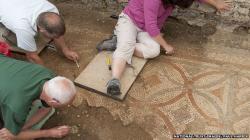 Chedworth - A new archaeological dig is to take place to uncover floor mosaics at Chedworth Roman villa in Gloucestershire. The mosaics in the north range were last uncovered in the 1960s but records of the dig have not survived. Experts want to assess the state of the archaeology that still survives, to establish what further excavations and conservation work should take place. National Trust archaeologist Dr Martin Papworth, who is directing the excavations, said: "We believe the mosaics and remains on the north range are at least as extensive and interesting and those now protected by the new west range building, so we want to assess exactly what is there and decide how best to protect them.”
Chedworth - A new archaeological dig is to take place to uncover floor mosaics at Chedworth Roman villa in Gloucestershire. The mosaics in the north range were last uncovered in the 1960s but records of the dig have not survived. Experts want to assess the state of the archaeology that still survives, to establish what further excavations and conservation work should take place. National Trust archaeologist Dr Martin Papworth, who is directing the excavations, said: "We believe the mosaics and remains on the north range are at least as extensive and interesting and those now protected by the new west range building, so we want to assess exactly what is there and decide how best to protect them.”
http://www.bbc.co.uk/news/uk-england-gloucestershire-23738783
ROYAUME UNI – 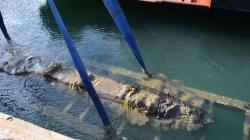
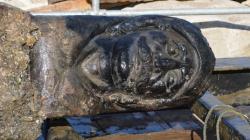 Poole - The rudder of a 17th Century merchant vessel shipwrecked off the Dorset coast has been brought ashore. The so-called Swash Channel Wreck was discovered in a sand and shingle bank outside Poole Harbour that was struck by a dredger in 1990. Its 8.4m (28ft) rudder, carved with the image of a man's face, was lifted onto Poole Quay by Bournemouth University marine archaeologists. Little is known about the name and origins of the vessel and its crew. Almost 80% of the port side of the Dutch ship survived since it sank early in the 17th Century. The rudder is the last major piece due to be raised. The wreck has since been covered in sand to protect it from the seawater.
Poole - The rudder of a 17th Century merchant vessel shipwrecked off the Dorset coast has been brought ashore. The so-called Swash Channel Wreck was discovered in a sand and shingle bank outside Poole Harbour that was struck by a dredger in 1990. Its 8.4m (28ft) rudder, carved with the image of a man's face, was lifted onto Poole Quay by Bournemouth University marine archaeologists. Little is known about the name and origins of the vessel and its crew. Almost 80% of the port side of the Dutch ship survived since it sank early in the 17th Century. The rudder is the last major piece due to be raised. The wreck has since been covered in sand to protect it from the seawater.
http://www.bbc.co.uk/news/uk-england-dorset-23731189
ROYAUME UNI – 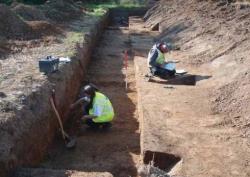 Felixstowe - Archaeologists have found evidence that the Walton Green site at Felixstowe had been occupied by Neolithic families, who would have lived up to 6,000 years ago – between 4000BC and 2500BC. Later the land was a large burial site with ritual cremations carried out in the Bronze Age, and then lived on and used for farming in the Iron Age, between 800BC and the arrival of the Romans in AD43. It provides a different view of Felixstowe, widely regarded as a Victorian and Edwardian resort, and before this as a small clifftop settlement with roots stretching back to its time as a Roman military base. Archaeologists who excavated the 30-acre site in Walton High Street say the area has good potential for helping further research, but it is uncertain whether they will be allowed to carry out a further dig. Among the finds were evidence of cremations and burial barrows, along with postholes from buildings, flint blades and tools, and nearly six kg of pottery fragments, most from thousands of years ago. Archaeologist Jonathan House said: “Of particular archaeological interest was the discovery of elements of a Early/Middle Bronze Age ritual funerary landscape that included a well preserved putative barrow and associated features such as secondary cremations. “Evidence for an agricultural landscape, along with possible beginnings of settlement in the form of post holes and possible round houses, was also recovered. “Occupation of the site appears to have continued into the late Bronze Age/Early Iron Age with the presence of at least one settlement area with a good, well preserved assemblage of pottery and other finds directly associated with settlement features. “Subsequently it appears that low level activity, predominantly agricultural in nature, continued on the site into the Post Medieval period.” The evidence for ritual funerals during the Bronze Age was of particular significance both locally and at a regional level. Also of interest was the sudden change from using the land as a place for burials to using it for farming. Mr House said: “The pit, and the finds of Neolithic date within tree throws, as well as the background scatter of flint objects, may suggest some tree clearance during the period; although it may be more likely that people were utilising the hollows left by uprooted trees or that the open hollows have preserved isolated pockets of material from an otherwise well used landscape.
Felixstowe - Archaeologists have found evidence that the Walton Green site at Felixstowe had been occupied by Neolithic families, who would have lived up to 6,000 years ago – between 4000BC and 2500BC. Later the land was a large burial site with ritual cremations carried out in the Bronze Age, and then lived on and used for farming in the Iron Age, between 800BC and the arrival of the Romans in AD43. It provides a different view of Felixstowe, widely regarded as a Victorian and Edwardian resort, and before this as a small clifftop settlement with roots stretching back to its time as a Roman military base. Archaeologists who excavated the 30-acre site in Walton High Street say the area has good potential for helping further research, but it is uncertain whether they will be allowed to carry out a further dig. Among the finds were evidence of cremations and burial barrows, along with postholes from buildings, flint blades and tools, and nearly six kg of pottery fragments, most from thousands of years ago. Archaeologist Jonathan House said: “Of particular archaeological interest was the discovery of elements of a Early/Middle Bronze Age ritual funerary landscape that included a well preserved putative barrow and associated features such as secondary cremations. “Evidence for an agricultural landscape, along with possible beginnings of settlement in the form of post holes and possible round houses, was also recovered. “Occupation of the site appears to have continued into the late Bronze Age/Early Iron Age with the presence of at least one settlement area with a good, well preserved assemblage of pottery and other finds directly associated with settlement features. “Subsequently it appears that low level activity, predominantly agricultural in nature, continued on the site into the Post Medieval period.” The evidence for ritual funerals during the Bronze Age was of particular significance both locally and at a regional level. Also of interest was the sudden change from using the land as a place for burials to using it for farming. Mr House said: “The pit, and the finds of Neolithic date within tree throws, as well as the background scatter of flint objects, may suggest some tree clearance during the period; although it may be more likely that people were utilising the hollows left by uprooted trees or that the open hollows have preserved isolated pockets of material from an otherwise well used landscape.
http://www.eadt.co.uk/news/felixstowe_archaeologists_shed_new_light_on_town_s_past_1_2342214
FRANCE – 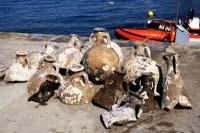 Marseille - VIDEO = En juillet dernier, des objets antiques ont été remontés de l'Anse du Pharo. Serge Ximénes, président et fondateur du groupe de recherche archéologique sous-marine (Grasm) est venu en dévoiler les secrets. Plusieurs centaines d'objets reposaient au fond de l'anse du Pharo depuis près de 2400 ans. Des céramiques, aussi bien grecques que campanéennes (de Naples) enfouies dans la vase. Mais plus largement, Serge Ximénes déplore un manque d'exploitation du patrimoine archéologique marin. "Dans la rade de Marseille, plus de 300 épaves découvertes restent à exploiter. Seulement c'est très cher de faire de l'archéologie sous-marine, à cause des besoins en matériel [...] , sans compter les coûts liés à la conservation et à la restauration." S'il n'y a aucune urgence à sortir les objets de l'eau, "s'ils pourraient attendre quelques siècles encore", la zone reste à risque pour les plongeurs à cause de la pollution. "La vase est imprégnée de plombs à cause des chantiers navals qui existaient à proximité. Il faut mettre des masques faciaux pour fouiller la vase". Lorsque ce chantier sera terminé, les plongeurs bénévoles du Grasm ne comptent pas s'arrêter là. Serge Ximénes espère poursuivre ses recherches au Pharo ou partir explorer les fonds de l'île Plane où une épave sarrasine d'Espagne a été découverte dans les années 1975.
Marseille - VIDEO = En juillet dernier, des objets antiques ont été remontés de l'Anse du Pharo. Serge Ximénes, président et fondateur du groupe de recherche archéologique sous-marine (Grasm) est venu en dévoiler les secrets. Plusieurs centaines d'objets reposaient au fond de l'anse du Pharo depuis près de 2400 ans. Des céramiques, aussi bien grecques que campanéennes (de Naples) enfouies dans la vase. Mais plus largement, Serge Ximénes déplore un manque d'exploitation du patrimoine archéologique marin. "Dans la rade de Marseille, plus de 300 épaves découvertes restent à exploiter. Seulement c'est très cher de faire de l'archéologie sous-marine, à cause des besoins en matériel [...] , sans compter les coûts liés à la conservation et à la restauration." S'il n'y a aucune urgence à sortir les objets de l'eau, "s'ils pourraient attendre quelques siècles encore", la zone reste à risque pour les plongeurs à cause de la pollution. "La vase est imprégnée de plombs à cause des chantiers navals qui existaient à proximité. Il faut mettre des masques faciaux pour fouiller la vase". Lorsque ce chantier sera terminé, les plongeurs bénévoles du Grasm ne comptent pas s'arrêter là. Serge Ximénes espère poursuivre ses recherches au Pharo ou partir explorer les fonds de l'île Plane où une épave sarrasine d'Espagne a été découverte dans les années 1975.
http://www.marsactu.fr/environnement/dans-la-rade-de-marseille-il-reste-plus-de-300-epaves-a-exploiter-31870.html
FRANCE – 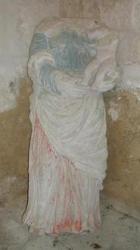 Ménigoute - Sur les fondations d'une chapelle à Saint-Giraud de Chantecorps eut lieu vers 1890 une étrange découverte : « une grande statue de la Vierge à l'enfant, datant du XIVe siècle, aux têtes cassées et en calcaire, statue qui serait au musée de Niort. » Ces propos énigmatiques proviennent de la monographie consacrée à l'abbaye royale Notre-Dame des Châtelliers par Ph. X. Michaud. Une statue ressemblant étrangement à cette description se trouve en dépôt au musée Raoul-Royer de Ménigoute. La similitude pourrait en rester là si cette œuvre religieuse n'avait pas été récupérée à Vausseroux, il y a un quart de siècle, alors qu'elle croupissait, abandonnée dans un recoin. Or, à la fin des années 1800, de nombreux objets mobiliers, provenant de l'abbatiale des Châtelliers sont venus rejoindre l'église de Vausseroux, tout juste construite. La statue avait peut-être aussi cette vocation d'ornement du nouveau lieu de culte mais, tronquée de ses têtes, elle a alors été laissée en déshérence. Les personnages décapités peuvent être des séquelles des guerres de religion ou de la révolution française. D'autres signes font pencher pour la deuxième option. En effet, les plis du vêtement féminin, initialement vert sous-bois, ont été recouverts sur le buste de bleu, à la ceinture de blanc et au niveau de la jupe de rouge. De plus, le courageux iconoclaste a signé son forfait au dos de la sculpture : « Messire P Thomas C Pillac 1791 ». Une autre sculpture accompagne la Vierge à l'enfant, elle aussi décapitée, mais non repeinte, et de même facture que sa vis-à-vis. Elle représente un prélat de haute lignée, au vêtement orné de fleurs de lys et avec un tout petit mendiant accroché aux replis de sa robe.
Ménigoute - Sur les fondations d'une chapelle à Saint-Giraud de Chantecorps eut lieu vers 1890 une étrange découverte : « une grande statue de la Vierge à l'enfant, datant du XIVe siècle, aux têtes cassées et en calcaire, statue qui serait au musée de Niort. » Ces propos énigmatiques proviennent de la monographie consacrée à l'abbaye royale Notre-Dame des Châtelliers par Ph. X. Michaud. Une statue ressemblant étrangement à cette description se trouve en dépôt au musée Raoul-Royer de Ménigoute. La similitude pourrait en rester là si cette œuvre religieuse n'avait pas été récupérée à Vausseroux, il y a un quart de siècle, alors qu'elle croupissait, abandonnée dans un recoin. Or, à la fin des années 1800, de nombreux objets mobiliers, provenant de l'abbatiale des Châtelliers sont venus rejoindre l'église de Vausseroux, tout juste construite. La statue avait peut-être aussi cette vocation d'ornement du nouveau lieu de culte mais, tronquée de ses têtes, elle a alors été laissée en déshérence. Les personnages décapités peuvent être des séquelles des guerres de religion ou de la révolution française. D'autres signes font pencher pour la deuxième option. En effet, les plis du vêtement féminin, initialement vert sous-bois, ont été recouverts sur le buste de bleu, à la ceinture de blanc et au niveau de la jupe de rouge. De plus, le courageux iconoclaste a signé son forfait au dos de la sculpture : « Messire P Thomas C Pillac 1791 ». Une autre sculpture accompagne la Vierge à l'enfant, elle aussi décapitée, mais non repeinte, et de même facture que sa vis-à-vis. Elle représente un prélat de haute lignée, au vêtement orné de fleurs de lys et avec un tout petit mendiant accroché aux replis de sa robe.
http://www.lanouvellerepublique.fr/Deux-Sevres/Loisirs/Patrimoine-tourisme/n/Contenus/Articles/2013/08/18/Le-mystere-de-la-statue-decapitee-1581754